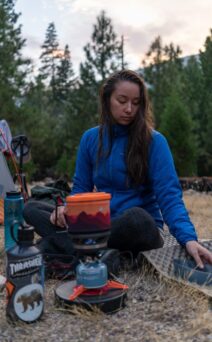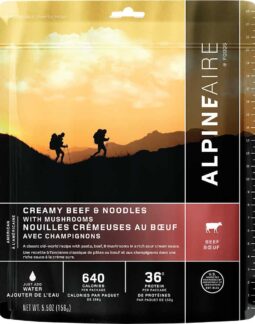Backpacking Meals
What backpacking meals can you eat outdoors? Freeze dried, dehydrated or what? With so many choices available to the average backpacker, it is important to know what kind of ingredients are in your food. Let’s take a look at what you need for lightweight backpacking meals and how they help you stay energized on the trail.

See Wilderness Survival Essentials for other items you’ll need on the trail, like a lightweight stove and eating utensils.
The first rule of lightweight backpacking meals is to choose foods that require little preparation. The less time you have to spend playing chef the more time you can spend enjoying your outdoor adventure. It’s important to keep in mind increasing calorie intake with increasing elevation and daily increasing physical activity.
There are many types of packaged backpacking meals. From freeze dried to dehydrated, there is an option for everyone. The best part about these meals is that they require little to no preparation. Simply add hot water and you’re good to go. This makes them perfect for on-the-go adventures.
Packaged Backpacking Meals: Pros and Cons
While packaged backpacking meals have many benefits, there are a few drawbacks as well. One downside is that they can be expensive. Another is that they can be high in calories, which can be a problem if you’re trying to lose weight. Additionally, they can be high in sodium, which isn’t ideal if you’re on a restricted diet.
Despite these drawbacks, packaged backpacking meals are convenient and lightweight. They provide quality nutrition, which makes them a popular choice among hikers.
Distinguishing Ingredients
Many of the ingredients in packaged backpacking meals are very similar. They are all high in protein. Many have added salt for added flavor or sodium to replace lost electrolytes during strenuous activities. Some may include carbohydrate sources as well, such as instant rice or couscous. Most also have fruit pouches to add a little sweetness to the meal.
Freeze Dried Meals
Of all the types of packaged backpacking meals, freeze dried meals are probably the most popular among backpackers today. They usually require adding cold water to the meal. This is often done with a special pouch, which the user pours water into and lets soak for a few minutes before enjoying their meal.
Freeze dried meals can be pricey but they are lightweight and require little to no preparation. Some popular brands of freeze dried meals include:
Dehydrated Meals
Another type of packaged backpacking meal is the dehydrated meal. These are available in many varieties and usually require adding boiling water to rehydrate them before eating. Dehydrated meals are lightweight, but they take the longest to prepare out of all packaged backpacking meals. Some popular brands include, Mountain House, Happy Yak, and Alpineaire to name a few.
Best Lightweight Backpacking Meals;
Lightweight Backpacking Meals on The Trail
Whenever you’re on a backpacking trip, it’s important to think about energy levels. Hiking uses a lot of calories and backpackers need to replenish them. Be sure to follow the rule of 3’s while on the trail:
•3 Hours Between Meals for Maximum Energy
•3 Days Before Rested to Prevent Fatigue
•3 General Food Groups for Balanced Nutrition
With these tips, you’ll be sure to have a wonderful backpacking experience whether you’re out on the trail for 1 hour or 5 days. You’ll know what lightweight backpacking meals are best for your body and how to keep energized while hiking!
“Simple to use and lightweight: these are just two of the perks of backpacking meals. Many outdoor stores like MEC and REI sell pre-packaged backpacking meals that make thru-hiking easy.”
Disclosure
Keep in mind that I may receive commissions when you click our links and make purchases. I am endeavoring to find you the best of the best as well as alternate options. I try to keep things fair and balanced, in order to help you make the best choice for you.

